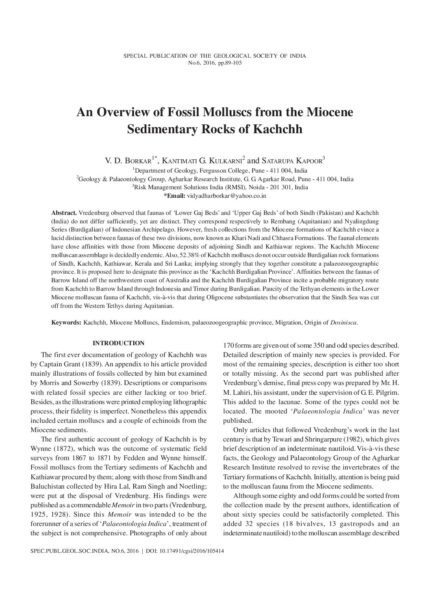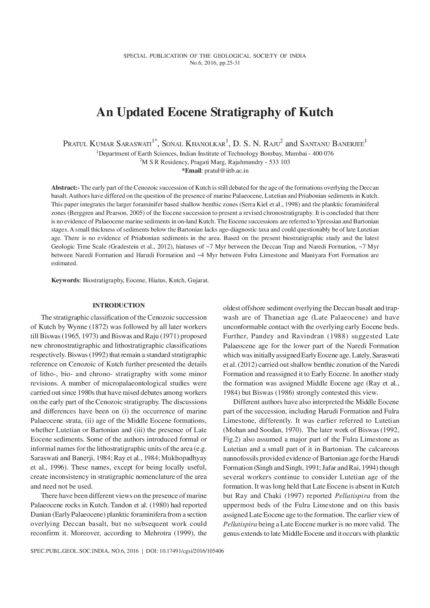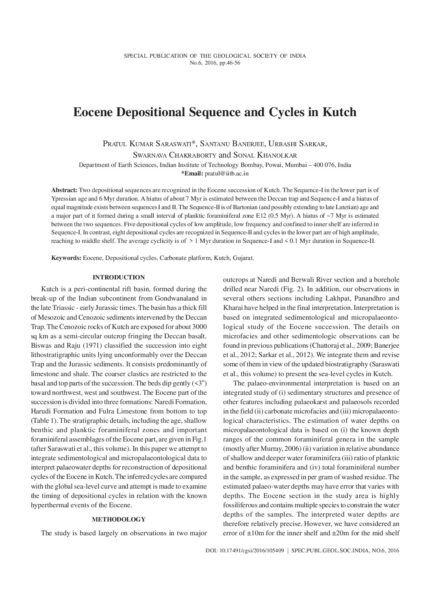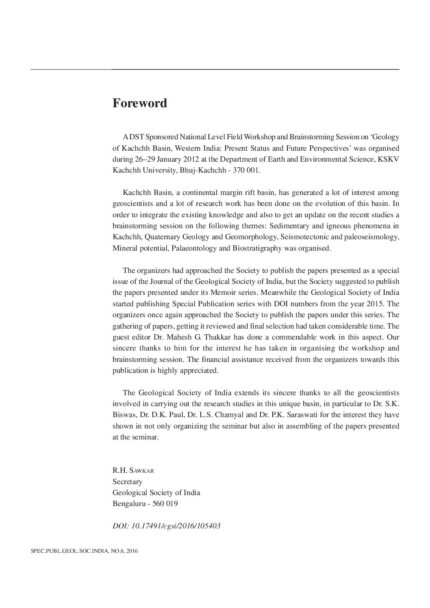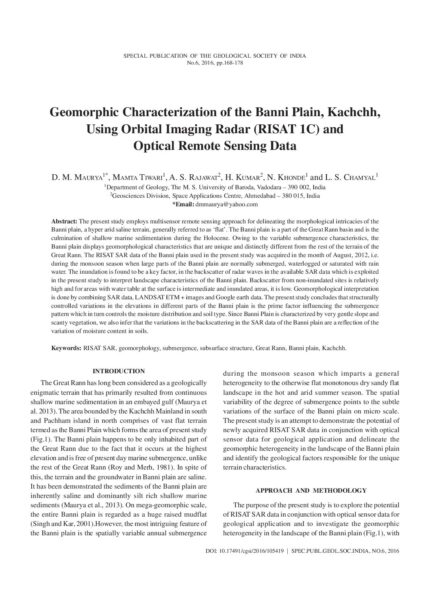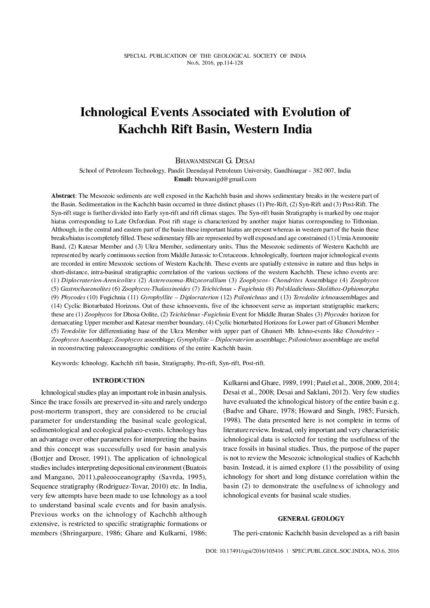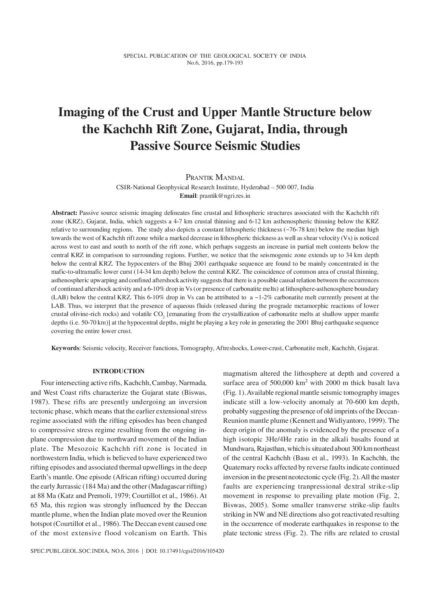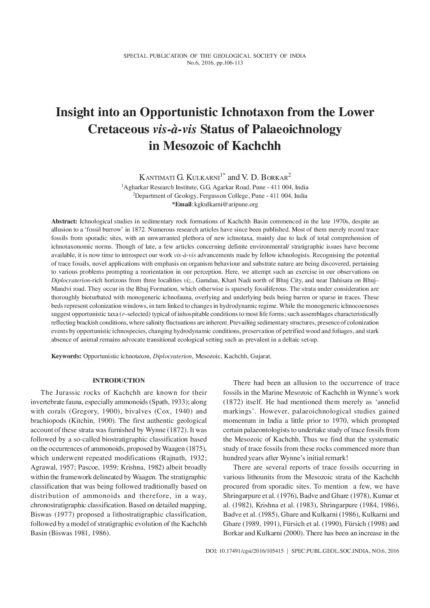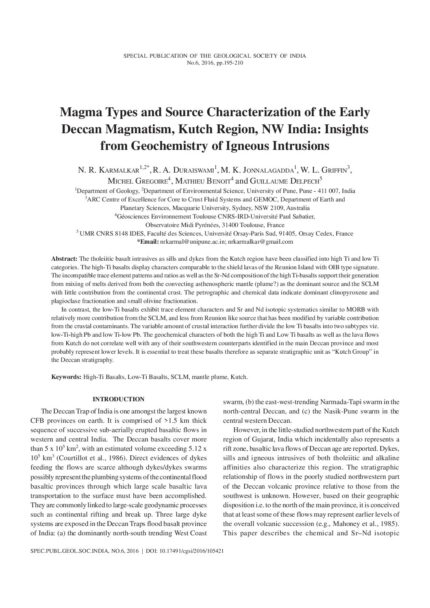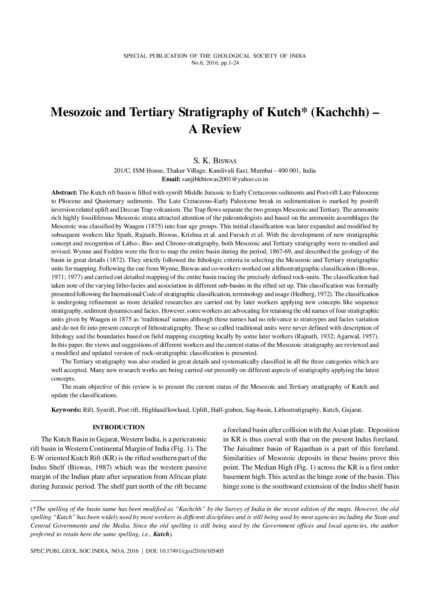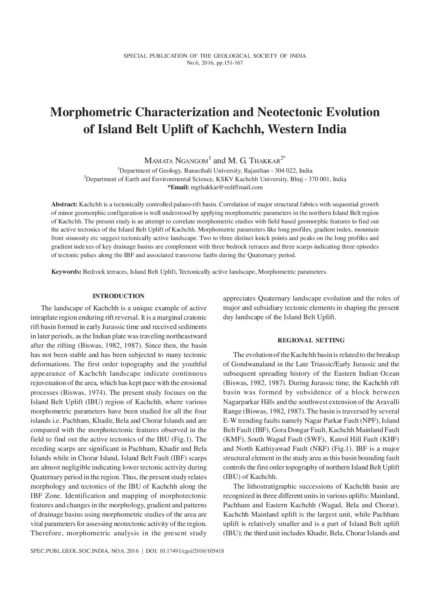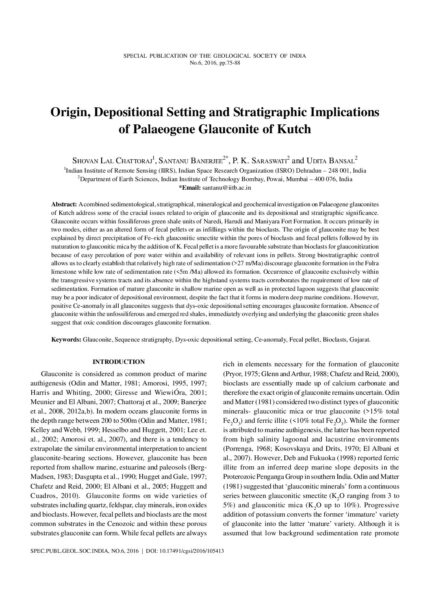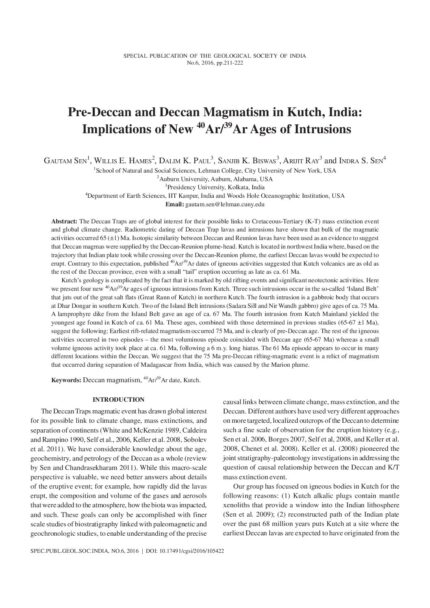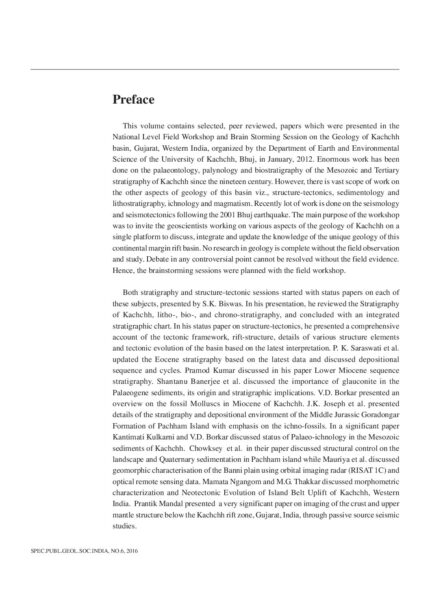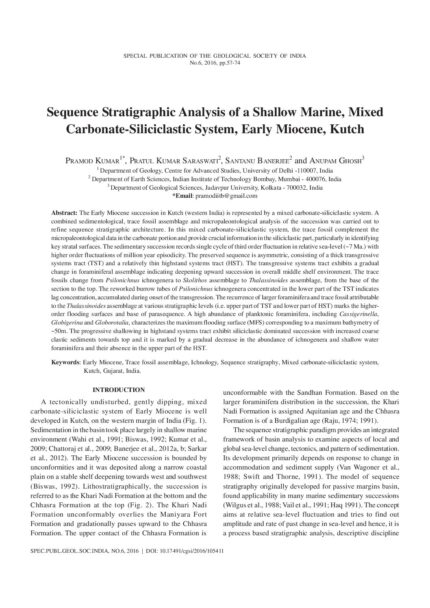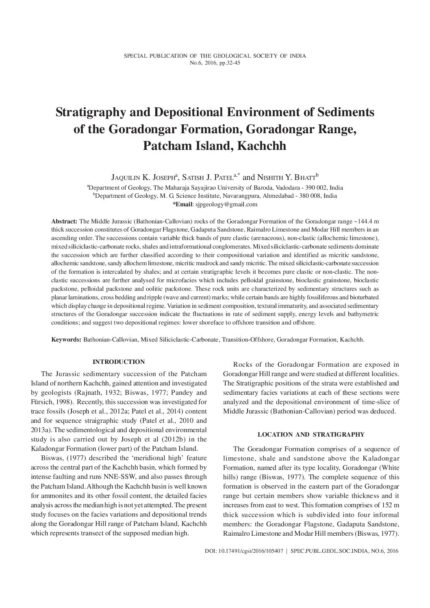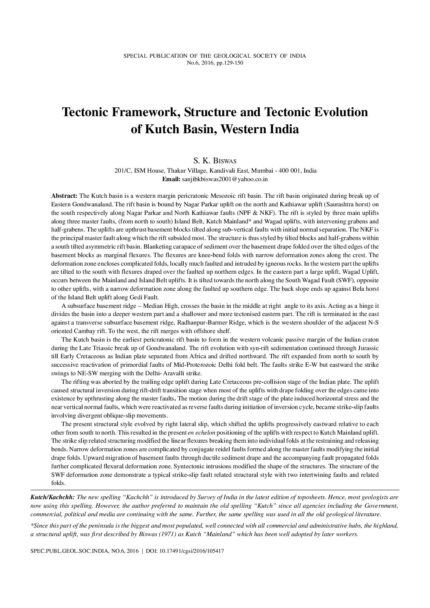SP-06: Recent Studies on the Geology of Kachchh
An Overview of Fossil Molluscs from the Miocene Sedimentary Rocks of Kachchh
SKU:
C-105414
Vredenburg observed that faunas of 'Lower Gaj Beds' and 'Upper Gaj Beds' of both Sindh (Pakistan) and Kachchh (India) do not differ sufficiently, yet are distinct. They correspond respectively to Rembang (Aquitanian) and Nyalingdung Series (Burdigalian) of Indonesian Archipelago. However, fresh collections from the Miocene formations of Kachchh evince a lucid distinction between faunas of these two divisions, now known as Khari Nadi and Chhasra Formations. The faunal elements have close affinities with those from Miocene deposits of adjoining Sindh and Kathiawar regions. The Kachchh Miocene molluscan assemblage is decidedly endemic. Also, 52.38% of Kachchh molluscs do not occur outside Burdigalian rock formations of Sindh, Kachchh, Kathiawar, Kerala and Sri Lanka; implying strongly that they together constitute a palaeozoogeographic province. It is proposed here to designate this province as the 'Kachchh Burdigalian Province'. Affinities between the faunas of Barrow Island off the northwestern coast of Australia and the Kachchh Burdigalian Province incite a probable migratory route from Kachchh to Barrow Island through Indonesia and Timor during Burdigalian. Paucity of the Tethyan elements in the Lower Miocene molluscan fauna of Kachchh, vis-?-vis that during Oligocene substantiates the observation that the Sindh Sea was cut off from the Western Tethys during Aquitanian.
An Updated Eocene Stratigraphy of Kutch
SKU:
C-105406
The early part of the Cenozoic succession of Kutch is still debated for the age of the formations overlying the Deccan basalt. Authors have differed on the question of the presence of marine Palaeocene, Lutetian and Priabonian sediments in Kutch. This paper integrates the larger foraminifer based shallow benthic zones (Serra Kiel et al., 1998) and the planktic foraminiferal zones (Berggren and Pearson, 2005) of the Eocene succession to present a revised chronostratigraphy. It is concluded that there is no evidence of Palaeocene marine sediments in on-land Kutch. The Eocene successions are referred to Ypressian and Bartonian stages. A small thickness of sediments below the Bartonian lacks age-diagnostic taxa and could questionably be of late Lutetian age. There is no evidence of Priabonian sediments in the area. Based on the present biostratigraphic study and the latest Geologic Time Scale (Gradestein et al., 2012), hiatuses of ~7 Myr between the Deccan Trap and Naredi Formation, ~7 Myr between Naredi Formation and Harudi Formation and ~4 Myr between Fulra Limestone and Maniyara Fort Formation are estimated.
Eocene Depositional Sequence and Cycles in Kutch
SKU:
C-105409
Two depositional sequences are recognized in the Eocene succession of Kutch. The Sequence-I in the lower part is of Ypressian age and 6 Myr duration. A hiatus of about 7 Myr is estimated between the Deccan trap and Sequence-I and a hiatus of equal magnitude exists between sequences I and II. The Sequence-II is of Bartonian (and possibly extending to late Lutetian) age and a major part of it formed during a small interval of planktic foraminiferal zone E12 (0.5 Myr). A hiatus of ~7 Myr is estimated between the two sequences. Five depositional cycles of low amplitude, low frequency and confined to inner shelf are inferred in Sequence-I. In contrast, eight depositional cycles are recognized in Sequence-II and cycles in the lower part are of high amplitude, reaching to middle shelf. The average cyclicity is of > 1 Myr duration in Sequence-I and < 0.1 Myr duration in Sequence-II.
Geomorphic Characterization of the Banni Plain, Kachchh, Using Orbital Imaging Radar (RISAT 1C) and Optical Remote Sensing Data
SKU:
C-105419
The present study employs multisensor remote sensing approach for delineating the morphological intricacies of the Banni plain, a hyper arid saline terrain, generally referred to as 'flat'. The Banni plain is a part of the Great Rann basin and is the culmination of shallow marine sedimentation during the Holocene. Owing to the variable submergence characteristics, the Banni plain displays geomorphological characteristics that are unique and distinctly different from the rest of the terrain of the Great Rann. The RISAT SAR data of the Banni plain used in the present study was acquired in the month of August, 2012, i.e. during the monsoon season when large parts of the Banni plain are normally submerged, waterlogged or saturated with rain water. The inundation is found to be a key factor, in the backscatter of radar waves in the available SAR data which is exploited in the present study to interpret landscape characteristics of the Banni plain. Backscatter from non-inundated sites is relatively high and for areas with water table at the surface is intermediate and inundated areas, it is low. Geomorphological interpretation is done by combining SAR data, LANDSAT ETM + images and Google earth data. The present study concludes that structurally controlled variations in the elevations in different parts of the Banni plain is the prime factor influencing the submergence pattern which in turn controls the moisture distribution and soil type. Since Banni Plain is characterized by very gentle slope and scanty vegetation, we also infer that the variations in the backscattering in the SAR data of the Banni plain are a reflection of the variation of moisture content in soils.
Ichnological Events Associated with Evolution of Kachchh Rift Basin, Western India
SKU:
C-105416
The Mesozoic sediments are well exposed in the Kachchh basin and shows sedimentary breaks in the western part of the Basin. Sedimentation in the Kachchh basin occurred in three distinct phases (1) Pre-Rift, (2) Syn-Rift and (3) Post-Rift. The Syn-rift stage is further divided into Early syn-rift and rift climax stages. The Syn-rift basin Stratigraphy is marked by one major hiatus corresponding to Late Oxfordian. Post rift stage is characterized by another major hiatus corresponding to Tithonian. Although, in the central and eastern part of the basin these important hiatus are present whereas in western part of the basin these breaks/hiatus is completely filled. These sedimentary fills are represented by well exposed and age constrained (1) Umia Ammonite Band, (2) Katesar Member and (3) Ukra Member, sedimentary units. Thus the Mesozoic sediments of Western Kachchh are represented by nearly continuous section from Middle Jurassic to Cretaceous. Ichnologically, fourteen major ichnological events are recorded in entire Mesozoic sections of Western Kachchh. These events are spatially extensive in nature and thus helps in short-distance, intra-basinal stratigraphic correlation of the various sections of the western Kachchh. These ichno events are: (1) Diplocraterion-Arenicolites (2) Astereosoma-Rhizocorallium (3) Zoophycos- Chondrites Assemblage (4) Zoophycos (5) Gastrochaeonolites (6) Zoophycos-Thalassinoides (7) Teichichnus - Fugichnia (8) Polykladichnus-Skolithos-Ophiomorpha (9) Phycodes (10) Fugichnia (11) Gyrophyllite - Diplocraterion (12) Psilonichnus and (13) Teredolite ichnoassemblages and (14) Cyclic Bioturbated Horizons. Out of these ichnoevents, five of the ichnoevent serve as important stratigraphic markers; these are (1) Zoophycos for Dhosa Oolite, (2) Teichichnus -Fugichnia Event for Middle Jhuran Shales (3) Phycodes horizon for demarcating Upper member and Katesar member boundary, (4) Cyclic bioturbated Horizons for Lower part of Ghuneri Member (5) Teredolite for differentiating base of the Ukra Member with upper part of Ghuneri Mb. Ichno-events like Chondrites - Zoophycos Assemblage; Zoophycos assemblage; Gyrophyllite - Diplocraterion assemblage; Psilonichnus assemblage are useful in reconstructing paleooceanographic conditions of the entire Kachchh basin.
Imaging of the Crust and Upper Mantle Structure below the Kachchh Rift Zone, Gujarat, India, through Passive Source Seismic Studies
SKU:
C-105420
Passive source seismic imaging delineates fine crustal and lithospheric structures associated with the Kachchh rift zone (KRZ), Gujarat, India, which suggests a 4-7 km crustal thinning and 6-12 km asthenospheric thinning below the KRZ relative to surrounding regions. The study also depicts a constant lithospheric thickness (~76-78 km) below the median high towards the west of Kachchh rift zone while a marked decrease in lithospheric thickness as well as shear velocity (Vs) is noticed across west to east and south to north of the rift zone, which perhaps suggests an increase in partial melt contents below the central KRZ in comparison to surrounding regions. Further, we notice that the seismogenic zone extends up to 34 km depth below the central KRZ. The hypocenters of the Bhuj 2001 earthquake sequence are found to be mainly concentrated in the mafic-to-ultramafic lower curst (14-34 km depth) below the central KRZ. The coincidence of common area of crustal thinning, asthenospheric upwarping and confined aftershock activity suggests that there is a possible causal relation between the occurrences of continued aftershock activity and a 6-10% drop in Vs (or presence of carbonatite melts) at lithosphere-asthenosphere boundary (LAB) below the central KRZ. This 6-10% drop in Vs can be attributed to a ~1-2% carbonatite melt currently present at the LAB. Thus, we interpret that the presence of aqueous fluids (released during the prograde metamorphic reactions of lower crustal olivine-rich rocks) and volatile CO2 [emanating from the crystallization of carbonatite melts at shallow upper mantle depths (i.e. 50-70 km)] at the hypocentral depths, might be playing a key role in generating the 2001 Bhuj earthquake sequence covering the entire lower crust.
Insight into an Opportunistic Ichnotaxon from the Lower Cretaceous vis-?-vis Status of Palaeoichnology in Mesozoic of Kachchh
SKU:
C-105415
Ichnological studies in sedimentary rock formations of Kachchh Basin commenced in the late 1970s, despite an allusion to a 'fossil burrow' in 1872. Numerous research articles have since been published. Most of them merely record trace fossils from sporadic sites, with an unwarranted plethora of new ichnotaxa, mainly due to lack of total comprehension of ichnotaxonomic norms. Though of late, a few articles concerning definite environmental/stratigraphic issues have become available, it is now time to introspect our work vis-?-vis advancements made by fellow ichnologists. Recognising the potential of trace fossils, novel applications with emphasis on organism behaviour and substrate nature are being discovered, pertaining to various problems prompting a reorientation in our perception. Here, we attempt such an exercise in our observations on Diplocraterion-rich horizons from three localities viz., Gamdau, Khari Nadi north of Bhuj City, and near Dahisara on Bhuj- Mandvi road. They occur in the Bhuj Formation, which otherwise is sparsely fossiliferous. The strata under consideration are thoroughly bioturbated with monogeneric ichnofauna, overlying and underlying beds being barren or sparse in traces. These beds represent colonization windows, in turn linked to changes in hydrodynamic regime. While the monogeneric ichnocoenoses suggest opportunistic taxa (r-selected) typical of inhospitable conditions to most life forms; such assemblages characteristically reflecting brackish conditions, where salinity fluctuations are inherent. Prevailing sedimentary structures, presence of colonization events by opportunistic ichnospecies, changing hydrodynamic conditions, preservation of petrified wood and foliages, and stark absence of animal remains advocate transitional ecological setting such as prevalent in a deltaic set-up.
Magma Types and Source Characterization of the Early Deccan Magmatism, Kutch Region, NW India:Insights from Geochemistry of Igneous Intrusions
SKU:
C-105421
The tholeiitic basalt intrusives as sills and dykes from the Kutch region have been classified into high Ti and low Ti categories. The high-Ti basalts display characters comparable to the shield lavas of the Reunion Island with OIB type signature. The incompatible trace element patterns and ratios as well as the Sr-Nd composition of the high Ti-basalts support their generation from mixing of melts derived from both the convecting asthenospheric mantle (plume?) as the dominant source and the SCLM with little contribution from the continental crust. The petrographic and chemical data indicate dominant clinopyroxene and plagioclase fractionation and small olivine fractionation.In contrast, the low-Ti basalts exhibit trace element characters and Sr and Nd isotopic systematics similar to MORB with relatively more contribution from the SCLM, and less from Reunion like source that has been modified by variable contribution from the crustal contaminants. The variable amount of crustal interaction further divide the low Ti basalts into two subtypes viz. low-Ti-high Pb and low Ti-low Pb. The geochemical characters of both the high Ti and Low Ti basalts as well as the lava flows from Kutch do not correlate well with any of their southwestern counterparts identified in the main Deccan province and most probably represent lower levels. It is essential to treat these basalts therefore as separate stratigraphic unit as "Kutch Group" in the Deccan stratigraphy.
Mesozoic and Tertiary Stratigraphy of Kutch* (Kachchh) ? A Review
SKU:
C-105405
The Kutch rift basin is filled with synrift Middle Jurassic to Early Cretaceous sediments and Post-rift Late Paleocene to Pliocene and Quaternary sediments. The Late Cretaceous-Early Paleocene break in sedimentation is marked by postrift inversion related uplift and Deccan Trap volcanism. The Trap flows separate the two groups Mesozoic and Tertiary. The ammonite rich highly fossiliferous Mesozoic strata attracted attention of the paleontologists and based on the ammonite assemblages the Mesozoic was classified by Waagen (1875) into four age groups. This initial classification was later expanded and modified by subsequent workers like Spath, Rajnath, Biswas, Krishna et al. and Fursich et al. With the development of new stratigraphic concept and recognition of Litho-, Bio- and Chrono-stratigraphy, both Mesozoic and Tertiary stratigraphy were re-studied and revised. Wynne and Fedden were the first to map the entire basin during the period, 1867-69, and described the geology of the basin in great details (1872). They strictly followed the lithologic criteria in selecting the Mesozoic and Tertiary stratigraphic units for mapping. Following the cue from Wynne, Biswas and co-workers worked out a lithostratigraphic classification (Biswas, 1971; 1977) and carried out detailed mapping of the entire basin tracing the precisely defined rock-units. The classification had taken note of the varying litho-facies and association in different sub-basins in the rifted set up. This classification was formally presented following the Inernational Code of stratigraphic classification, terminology and usage (Hedberg, 1972). The classification is undergoing refinement as more detailed researches are carried out by later workers applying new concepts like sequence stratigraphy, sediment dynamics and facies. However, some workers are advocating for retaining the old names of four stratigraphic units given by Waagen in 1875 as 'traditional' names although these names had no relevance to stratoypes and facies variation and do not fit into present concept of lithostratigraphy. These so called traditional units were never defined with description of lithology and the boundaries based on field mapping excepting locally by some later workers (Rajnath, 1932; Agarwal, 1957). In this paper, the views and suggestions of different workers and the current status of the Mesozoic stratigraphy are reviewed and a modified and updated version of rock-stratigraphic classification is presented.The Tertiary stratigraphy was also studied in great details and systematically classified in all the three categories which are well accepted. Many new research works are being carried out presently on different aspects of stratigraphy applying the latest concepts.The main objective of this review is to present the current status of the Mesozoic and Tertiary stratigraphy of Kutch and update the classifications.
Morphometric Characterization and Neotectonic Evolution of Island Belt Uplift of Kachchh, Western India
SKU:
C-105418
Kachchh is a tectonically controlled palaeo-rift basin. Correlation of major structural fabrics with sequential growth of minor geomorphic configuration is well understood by applying morphometric parameters in the northern Island Belt region of Kachchh. The present study is an attempt to correlate morphometric studies with field based geomorphic features to find out the active tectonics of the Island Belt Uplift of Kachchh. Morphometric parameters like long profiles, gradient index, mountain front sinuosity etc suggest tectonically active landscape. Two to three distinct knick points and peaks on the long profiles and gradient indexes of key drainage basins are complement with three bedrock terraces and three scarps indicating three episodes of tectonic pulses along the IBF and associated transverse faults during the Quaternary period.
Origin, Depositional Setting and Stratigraphic Implications of Palaeogene Glauconite of Kutch
SKU:
C-105413
A combined sedimentological, stratigraphical, mineralogical and geochemical investigation on Palaeogene glauconites of Kutch address some of the crucial issues related to origin of glauconite and its depositional and stratigraphic significance. Glauconite occurs within fossiliferous green shale units of Naredi, Harudi and Maniyara Fort Formation. It occurs primarily in two modes, either as an altered form of fecal pellets or as infillings within the bioclasts. The origin of glauconite may be best explained by direct precipitation of Fe-rich glauconitic smectite within the pores of bioclasts and fecal pellets followed by its maturation to glauconitic mica by the addition of K. Fecal pellet is a more favourable substrate than bioclasts for glauconitization because of easy percolation of pore water within and availability of relevant ions in pellets. Strong biostratigraphic control allows us to clearly establish that relatively high rate of sedimentation (>27 m/Ma) discourage glauconite formation in the Fulra limestone while low rate of sedimentation rate (<5m /Ma) allowed its formation. Occurrence of glauconite exclusively within the transgressive systems tracts and its absence within the highstand systems tracts corroborates the requirement of low rate of sedimentation. Formation of mature glauconite in shallow marine open as well as in protected lagoon suggests that glauconite may be a poor indicator of depositional environment, despite the fact that it forms in modern deep marine conditions. However, positive Ce-anomaly in all glauconites suggests that dys-oxic depositional setting encourages glauconite formation. Absence of glauconite within the unfossiliferous and emerged red shales, immediately overlying and underlying the glauconitic green shales suggest that oxic condition discourages glauconite formation.
Pre-Deccan and Deccan Magmatism in Kutch, India: Implications of New 40Ar/39Ar Ages of Intrusions
SKU:
C-105422
The Deccan Traps are of global interest for their possible links to Cretaceous-Tertiary (K-T) mass extinction event and global climate change. Radiometric dating of Deccan Trap lavas and intrusions have shown that bulk of the magmatic activities occurred 65 (?1) Ma. Isotopic similarity between Deccan and Reunion lavas have been used as an evidence to suggest that Deccan magmas were supplied by the Deccan-Reunion plume-head. Kutch is located in northwest India where, based on the trajectory that Indian plate took while crossing over the Deccan-Reunion plume, the earliest Deccan lavas would be expected to erupt. Contrary to this expectation, published 40Ar/39Ar dates of igneous activities suggested that Kutch volcanics are as old as the rest of the Deccan province, even with a small "tail" eruption occurring as late as ca. 61 Ma.Kutch's geology is complicated by the fact that it is marked by old rifting events and significant neotectonic activities. Here we present four new 40Ar/39Ar ages of igneous intrusions from Kutch. Three such intrusions occur in the so-called 'Island Belt' that juts out of the great salt flats (Great Rann of Kutch) in northern Kutch. The fourth intrusion is a gabbroic body that occurs at Dhar Dongar in southern Kutch. Two of the Island Belt intrusions (Sadara Sill and Nir Wandh gabbro) give ages of ca. 75 Ma. A lamprophyre dike from the Island Belt gave an age of ca. 67 Ma. The fourth intrusion from Kutch Mainland yielded the youngest age found in Kutch of ca. 61 Ma. These ages, combined with those determined in previous studies (65-67?1 Ma), suggest the following: Earliest rift-related magmatism occurred 75 Ma, and is clearly of pre-Deccan age. The rest of the igneous activities occurred in two episodes - the most voluminous episode coincided with Deccan age (65-67 Ma) whereas a small volume igneous activity took place at ca. 61 Ma, following a 6 m.y. long hiatus. The 61 Ma episode appears to occur in many different locations within the Deccan. We suggest that the 75 Ma pre-Deccan rifting-magmatic event is a relict of magmatism that occurred during separation of Madagascar from India, which was caused by the Marion plume.
Sequence Stratigraphic Analysis of a Shallow Marine, Mixed Carbonate-Siliciclastic System, Early Miocene, Kutch
SKU:
C-105411
The Early Miocene succession in Kutch (western India) is represented by a mixed carbonate-siliciclastic system. A combined sedimentological, trace fossil assemblage and micropaleontological analysis of the succession was carried out to refine sequence stratigraphic architecture. In this mixed carbonate-siliciclastic system, the trace fossil complement the micropaleontological data in the carbonate portion and provide crucial information in the siliciclastic part, particularly in identifying key stratal surfaces. The sedimentary succession records single cycle of third order fluctuation in relative sea-level (~7 Ma.) with higher order fluctuations of million year episodicity. The preserved sequence is asymmetric, consisting of a thick transgressive systems tract (TST) and a relatively thin highstand systems tract (HST). The transgressive systems tract exhibits a gradual change in foraminiferal assemblage indicating deepening upward succession in overall middle shelf environment. The trace fossils change from Psilonichnus ichnogenera to Skolithos assemblage to Thalassinoides assemblage, from the base of the section to the top. The reworked burrow tubes of Psilonichnus ichnogenera concentrated in the lower part of the TST indicates lag concentration, accumulated during onset of the transgression. The recurrence of larger foraminifera and trace fossil attributable to the Thalassinoides assemblage at various stratigraphic levels (i.e. upper part of TST and lower part of HST) marks the higherorder flooding surfaces and base of parasequence. A high abundance of planktonic foraminifera, including Cassigerinella, Globigerina and Globorotalia, characterizes the maximum flooding surface (MFS) corresponding to a maximum bathymetry of ~50m. The progressive shallowing in highstand systems tract exhibit siliciclastic dominated succession with increased coarse clastic sediments towards top and it is marked by a gradual decrease in the abundance of ichnogenera and shallow water foraminifera and their absence in the upper part of the HST.
Stratigraphy and Depositional Environment of Sediments of the Goradongar Formation, Goradongar Range, Patcham Island, Kachchh
SKU:
C-105407
The Middle Jurassic (Bathonian-Callovian) rocks of the Goradongar Formation of the Goradongar range ~144.4 m thick succession constitutes of Goradongar Flagstone, Gadaputa Sandstone, Raimalro Limestone and Modar Hill members in an ascending order. The successions contain variable thick bands of pure clastic (arenaceous), non-clastic (allochemic limestone), mixed siliciclastic-carbonate rocks, shales and intraformational conglomerates. Mixed siliciclastic-carbonate sediments dominate the succession which are further classified according to their compositional variation and identified as micritic sandstone, allochemic sandstone, sandy allochem limestone, micritic mudrock and sandy micritic. The mixed siliciclastic-carbonate succession of the formation is intercalated by shales; and at certain stratigraphic levels it becomes pure clastic or non-clastic. The nonclastic successions are further analysed for microfacies which includes pelloidal grainstone, bioclastic grainstone, bioclastic packstone, pelloidal packstone and oolitic packstone. These rock units are characterized by sedimentary structures such as planar laminations, cross bedding and ripple (wave and current) marks; while certain bands are highly fossiliferous and bioturbated which display change in depositional regime. Variation in sediment composition, textural immaturity, and associated sedimentary structures of the Goradongar succession indicate the fluctuations in rate of sediment supply, energy levels and bathymetric conditions; and suggest two depositional regimes: lower shoreface to offshore transition and offshore.
Tectonic Framework, Structure and Tectonic Evolution of Kutch Basin, Western India
SKU:
C-105417
The Kutch basin is a western margin pericratonic Mesozoic rift basin. The rift basin originated during break up of Eastern Gondwanaland. The rift basin is bound by Nagar Parkar uplift on the north and Kathiawar uplift (Saurashtra horst) on the south respectively along Nagar Parkar and North Kathiawar faults (NPF&NKF). The rift is styled by three main uplifts along three master faults, (from north to south) Island Belt, Kutch Mainland and Wagad uplifts, with intervening grabens and half-grabens. The uplifts are upthrust basement blocks tilted along sub-vertical faults with initial normal separation. The NKF is the principal master fault along which the rift subsided most. The structure is thus styled by tilted blocks and half-grabens within a south tilted asymmetric rift basin. Blanketing carapace of sediment over the basement drape folded over the tilted edges of the basement blocks as marginal flexures. The flexures are knee-bend folds with narrow deformation zones along the crest. The deformation zone encloses complicated folds, locally much faulted and intruded by igneous rocks. In the western part the uplifts are tilted to the south with flexures draped over the faulted up northern edges. In the eastern part a large uplift, Wagad Uplift, occurs between the Mainland and Island Belt uplifts. It is tilted towards the north along the South Wagad Fault (SWF), opposite to other uplifts, with a narrow deformation zone along the faulted up southern edge. The back slope ends up against Bela horst of the Island Belt uplift along Gedi Fault.A subsurface basement ridge - Median High, crosses the basin in the middle at right angle to its axis. Acting as a hinge it divides the basin into a deeper western part and a shallower and more tectonised eastern part. The rift is terminated in the east against a transverse subsurface basement ridge, Radhanpur-Barmer Ridge, which is the western shoulder of the adjacent N-S oriented Cambay rift. To the west, the rift merges with offshore shelf.The Kutch basin is the earliest pericratonic rift basin to form in the western volcanic passive margin of the Indian craton during the Late Triassic break up of Gondwanaland. The rift evolution with syn-rift sedimentation continued through Jurassic till Early Cretaceous as Indian plate separated from Africa and drifted northward. The rift expanded from north to south by successive reactivation of primordial faults of Mid-Proterozoic Delhi fold belt. The faults strike E-W but eastward the strike swings to NE-SW merging with the Delhi- Aravalli strike.The rifting was aborted by the trailing edge uplift during Late Cretaceous pre-collision stage of the Indian plate. The uplift caused structural inversion during rift-drift transition stage when most of the uplifts with drape folding over the edges came into existence by upthrusting along the master faults. The motion during the drift stage of the plate induced horizontal stress and the near vertical normal faults, which were reactivated as reverse faults during initiation of inversion cycle, became strike-slip faults involving divergent oblique-slip movements.The present structural style evolved by right lateral slip, which shifted the uplifts progressively eastward relative to each other from south to north. This resulted in the present en echelon positioning of the uplifts with respect to Kutch Mainland uplift. The strike slip related structuring modified the linear flexures breaking them into individual folds at the restraining and releasing bends. Narrow deformation zones are complicated by conjugate reidel faults formed along the master faults modifying the initial drape folds. Upward migration of basement faults through ductile sediment drape and the accompanying fault propagated folds further complicated flexural deformation zone. Syntectonic intrusions modified the shape of the structures. The structure of the SWF deformation zone demonstrate a typical strike-slip fault related structural style with two intertwining faults and related folds.Igneous rocks extensively intruded the Mesozoic sediments. Synrift plutonic activity and post rift hotspot related Deccan volcanism are two major magmatic events. Studies on the intrusive bodies and seismological data suggest the presence of an ultramafic magmatic body close to the crust-mantle boundary. This suggests mantle stretching, thinning and rupturing during rifting which led to deep crustal melting and formation of magma that intruded during inversion stage.

